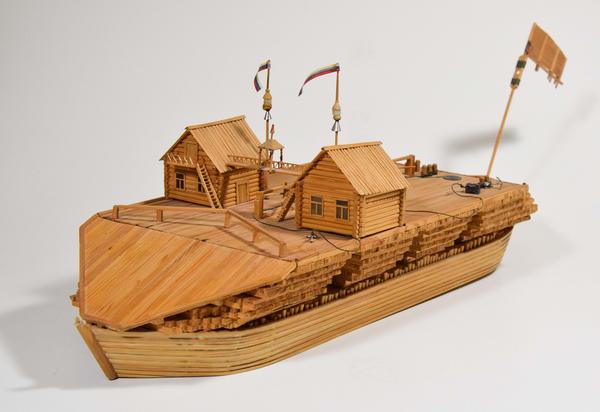A model of a Belyana — a Volga Timber Rafting Vessel — is displayed at the exhibition ‘Rarities of the Saratov Regional Museum’. The model is made of wood. A belyana is a flat-bottomed, wide vessel with a pointed bow and a stern loaded with timber. This cargo was stacked from the bottom of the boat to over its sides, which would form the deck of the boat, which was then covered with thin ‘doski’ (or boards). The area of the deck was roughly twice the size of the bottom of the boat. Three winches with ropes attached were positioned along the center line of the deck, towards the stern, to hold the anchors and the sounding line. Two wooden huts — called ‘kazyonki’ — were positioned side by side, with a carved cabin for the ship’s pilot between them. The belyana’s crew lived in these huts and used them to store supplies. A tall flagpole stood at the vessel’s stern. Smaller standards were positioned next to the huts.
Around 240 pine and 200 spruce beams were used to construct an average-sized Volga Belyana. The flat bottom was made from spruce beams, whilst the sides were made from pine. The distance between bulkheads — the curved transverse beams which ensured the strength and stability of the vessel’s sides and bilge — were no more than half a meter apart. The vessel’s hull was exceptionally strong as a result. Initially Belyanas were built without any nails. On the top deck, the vessel’s width could reach 30 meters. A number of winches were installed on the deck to lift the large anchors and to tighten up the ropes which held the timber.
Belyanas were used to transport firewood, railway sleepers and other cargo along the Volga river throughout the 18th and 19th centuries. The vessel earnt the name: ‘White Forest’, due to the yellow-white logs stripped of their bark, which were never tarred. This type of wood was loaded into the vessel’s hull, which was built for a single voyage. Ships arriving in the Volga’s lower reaches were sold along with their cargo, with the wood being used for construction as well as for firewood. The Belyana only moved by using the downstream current, which is why it can be called a raft. The payload capacity of this type of vessel ranged between 100,000 and 800,000 poods (over 13,000,000 kilograms). In the context of a massive demand for construction timber in the second half of the 18th century, Belyanas were the most convenient way to transport the material to Saratov Province.
Around 240 pine and 200 spruce beams were used to construct an average-sized Volga Belyana. The flat bottom was made from spruce beams, whilst the sides were made from pine. The distance between bulkheads — the curved transverse beams which ensured the strength and stability of the vessel’s sides and bilge — were no more than half a meter apart. The vessel’s hull was exceptionally strong as a result. Initially Belyanas were built without any nails. On the top deck, the vessel’s width could reach 30 meters. A number of winches were installed on the deck to lift the large anchors and to tighten up the ropes which held the timber.
Belyanas were used to transport firewood, railway sleepers and other cargo along the Volga river throughout the 18th and 19th centuries. The vessel earnt the name: ‘White Forest’, due to the yellow-white logs stripped of their bark, which were never tarred. This type of wood was loaded into the vessel’s hull, which was built for a single voyage. Ships arriving in the Volga’s lower reaches were sold along with their cargo, with the wood being used for construction as well as for firewood. The Belyana only moved by using the downstream current, which is why it can be called a raft. The payload capacity of this type of vessel ranged between 100,000 and 800,000 poods (over 13,000,000 kilograms). In the context of a massive demand for construction timber in the second half of the 18th century, Belyanas were the most convenient way to transport the material to Saratov Province.



